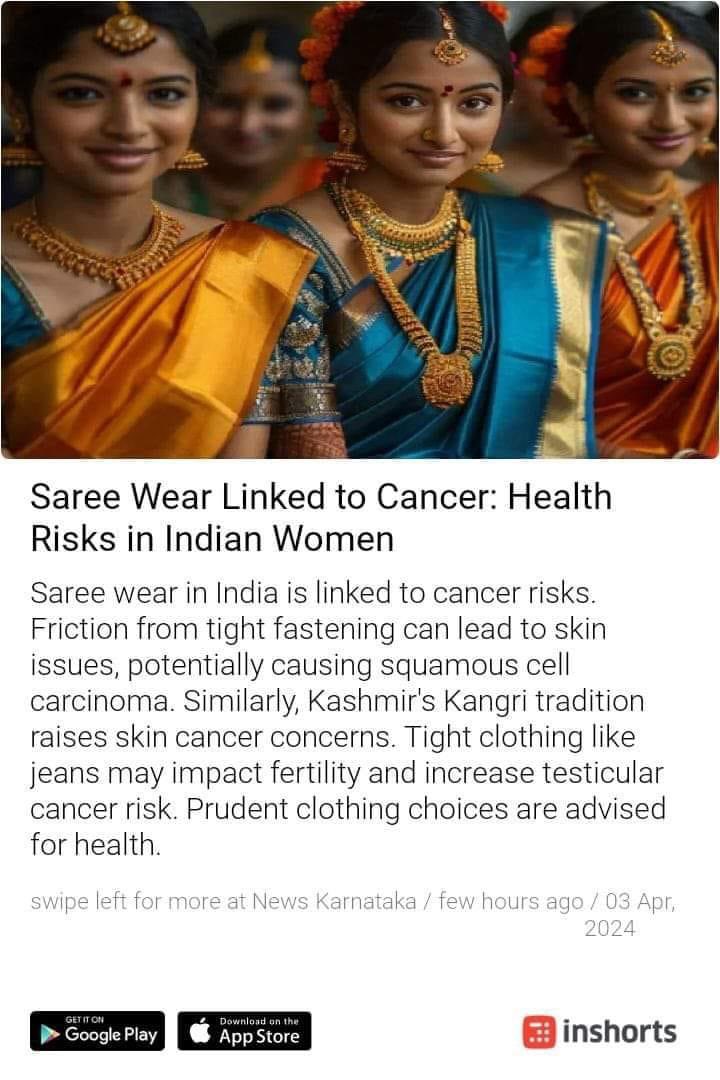An eagle-eyed netizen spotted a Sari Cancer distortion article on Inshorts. In this write-up the short-format news app makes sensational claims presenting the traditional Indian 6-yard drape as an agent of cancer among women. However, this short news article’s content was not just short of words but of scientific sense and logic as well! Its presentation on Sarees, Jeans, and Kashmiri Kangri in the same breadth as Cancer leads to a misrepresentation of the actual scientific study. Let’s talk about the Sari Cancer and confusion created by Inshorts among Indians.
Sari Cancer – The Scientific Reality

The Sari is a symbol of Bharat’s tradition and culture. Inshorts unjustly vilified this beautiful drape by presenting half-truths of a scientific study. The actual scientific research was published in 1945 by two Indian researchers Khanolkar and Suryabai. They linked the early 1900s discovery of Squamous Cell Carcinomas or SCC to conditions discovered in some ‘dhoti’ wearing patients’ skin issues. Thus, the actual term is not Sari Cancer or even Dhoti Cancer. The medical terminology is SCC or Squamous Cell Carcinomas, which deals with scarring, acanthosis, depigmentation, glazing of the skin, and eventually malignant transformation of the skin.
The SCC condition is not directly caused by wearing a sari or dhoti. Instead, factors such as poor hygiene, improper draping, and tight knots contribute to skin irritation and other issues. In Bharat malignant skin cancer comprises of less than 1% of the total malignancy reported in the nation. Thus, skin cancer directly due to tight knots of a saree or dhoti will be even more rare. Even scientific articles and studies highlight it as an extreme scenario where the continuous wear of a saree or dhoti with a tight knot can lead to Squamous Cell Carcinoma. However, this event would be an outlier, not the norm as porposed by Inshorts.
Sari Draping – Essential Hygiene and Practices

Beautiful though the sari is, wearing it requires skill and a sense of hygiene! Tight knots or bindings in clothes on a daily basis are bad for health. Thus, to enjoy the flowing folds of a sari or a dhoti, Indians must pay attention to their draping techniques. Additionally, wearers of the 6-yard drape must wash the sari and its accessories like the petticoat and blouse. These steps are essential to maintain hygiene and safety of health.
Bharat is a tropical nation. Its six seasons are beautiful as well as diverse. Each season asks sari lovers to choose different fabrics for comfort and well-being. Cotton for the summers, silks & satins for the winters, and any others mix of threads for the seasons in between. These choices of clothing fabrics help wearers avoid skin irritation at the waist and other parts. Thus, improper choice of fabric can also be a cause for skin issues that may culminate in cancer!
Therefore, rather than demonizing Bharat’s traditional clothing one should focus on the best ways to wear them. Essential practices of regular bathing, washing sarees regularly, and loose knots can significantly reduce the risk of SCC. Therefore, education on proper saree draping methods and hygiene can prevent even these rare cases of skin cancer!
Inshorts’ Misrepresentation of Sari Cancer

Inshorts took all the reasearch on SCC and turned it into a 60-second declaration against Sarees! However, its portrayal of Sarees as a cause of cancer is irresponsible and misleading. The objectionable post compared Sari Cancer to Kashmiri Kangri Cancer. Then it went ahead to state that wearing Jeans can cause infertility! By cherry-picking information on all these topics and sensationalizing them may have given Inshorts its required viewership counts. However, it also made the app a medium that perpetuates unfounded fears and misconceptions about Bharat’s traditional drape.
How we wish that instead of blaming the garment itself, the focus of the short-format news was on promoting Cancer awareness or even hygiene! The post seems to be encouraging women to make informed choices about their clothing, but it is presenting half-truths to influence the readers’ choice. Is this responsible journalism? Does the quest for high viewership allow the spreading of half-baked facts? Of course not! But who will hold the app responsible for this?
In Summary!
The Saree is a timeless symbol of Indian culture and tradition. Cherished by millions of women, its style of draping and its fabric changes across the country. The millennia-old drape will probably outlast any other style of modern fashion. Therefore, it should not be portrayed in such a negative light just to get quick views as a click-bait! It is unjust to malign this iconic garment based on isolated incidents and an ill-conceived understanding of the scientific study.
Health awareness is essential, however, it is also crucial to address the root causes of any disease. The rare SCC with its low-probability malignancy should not be used to defame the Dhoti or the Sari! Rather than scapegoating traditional clothing, Inshorts should have done better research with an open mind. With this aritcle, let’s clear the air around Sari Cancer myth! Let’s celebrate the beauty and elegance of the Saree while we responsibly promote awareness of SCC and hygiene!
References
- Takalkar, Unmesh & Asegaonkar, Shilpa & Kodlikeri, Pushpa & Kulkarni, Ujwala & Borundiya, Virendrakumar & Advani, Suresh. (2014). Saree Cancer in Indian Woman Treated Successfully with Multimodality Management. Dermatology reports. 6. 5128. 10.4081/dr.2014.5128. https://www.researchgate.net/publication/268234911_Saree_Cancer_in_Indian_Woman_Treated_Successfully_with_Multimodality_Management
- Akhtar, Murtaza & Saxena, Divish & Chikhlikar, Akanksha & Bangde, Akshay & Rangwala, Murtuza. (2015). Dhoti cancer: A waistline skin cancer with review of literature. World journal of surgical oncology. 13. 281. 10.1186/s12957-015-0698-z. https://www.researchgate.net/publication/282129732_Dhoti_cancer_A_waistline_skin_cancer_with_review_of_literature
- Rai, Pranjal & Ghag, Geeta & Sanjanwala, Saurabh & Jain, Rishabh & Nandu, Vipul. (2020). Saree Cancer: a Rare Case. Indian Journal of Surgical Oncology. 11. 10.1007/s13193-020-01061-2. https://www.researchgate.net/publication/340924930_Saree_Cancer_a_Rare_Case


